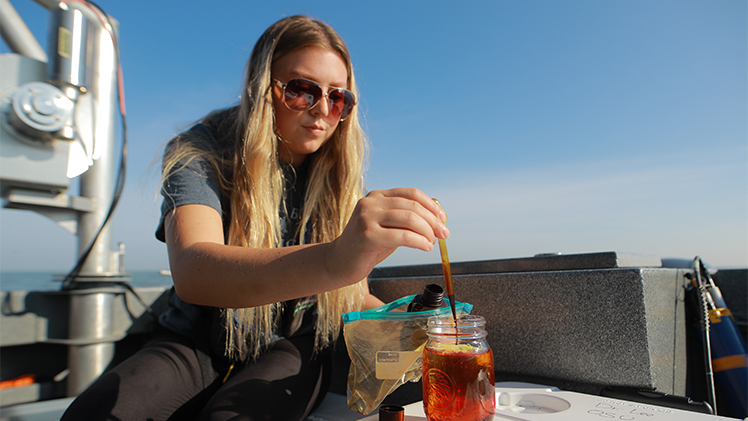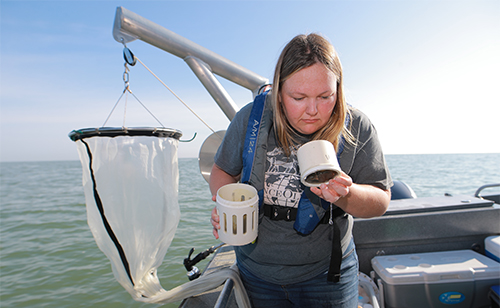Undergraduate student researcher Grace Edinger is on giant straw duty aboard The University of Toledo’s 28-foot research vessel.
At all eight water sampling stops covering 45 miles of Lake Erie’s western basin on a 75-degree day in late September, the senior studying environmental sciences stuck a long, white tube down to the bottom of the lake, pulled it up and emptied it into a bucket.

Grace Edinger, a senior studying environmental sciences, drops iodine into a water sample aboard the UToledo research vessel in Lake Erie.
Like putting a finger over the top of a drinking straw, she is making sure the research crew is not only sampling the surface, but the bottom of the water column too.
“I grew up fishing and boating on the lake,” said Edinger, who is from Toledo and a graduate of St. Ursula Academy. “Lake Erie is an important resource and we need to protect it. I want a career that keeps me on the water, so I’ve been working as a technician on this team throughout the summer.”
The first stop of the day is near what’s known as the crib, the city of Toledo’s water intake pipe that pumps raw lake water into the water treatment plant that supplies water to approximately 500,000 people.
Armed with data gathered throughout algal bloom season from summer into early fall, UToledo researchers give the early warning to water treatment plant operators if toxic algae in the bay is heading to the water intake so utility managers can adjust treatment to maintain drinking water safety.
“Even though the algal bloom is dying for the year, our water monitoring remains critical as we are starting to see some signal of cyanobacteria cell breakage,” said Dr. Thomas Bridgeman, director of the UToledo Lake Erie Center and professor of ecology. “If the cells break open, they release toxin. Dissolved toxin is more challenging for water treatment plants to remove because it can pass through filters and must be removed by chemical means before water leaves the plant for our faucets.”

Tony Tomalewski, a senior studying environmental sciences, takes readings using a device called a YSI sonde, which is comprised of several probes to measure water quality parameters, including water temperature, oxygen levels, pH, turbidity and algal pigments.
Bridgeman, who has studied algal blooms in the Great Lakes for two decades, and his research team at UToledo collect samples and track cyanobacteria throughout Lake Erie’s western basin weekly during algal bloom season.
Edinger transferred the water from the bucket into bottles that’ll go back to the UToledo Lake Erie Center laboratories for analysis. In one bottle she dropped iodine into the water sample.
“The iodine stains and preserves the plankton floating around and lets us look at it under a microscope later in the lab,” said Tony Tomalewski, an undergraduate student researcher also working on the research vessel. “It also makes the plankton heavier, so it sinks to the bottom and makes it easier to pour out the water.”
Tomalewski is a senior from Bedford, Mich., just over the state line. At each water sampling location for the day, he took readings using a device called a YSI sonde, which is comprised of several probes to measure water quality parameters, including water temperature, oxygen levels, pH, turbidity and algal pigments.
“We’re really lucky here to be able to get out of the classroom and do such important research for our area,” Tomalewski said. “It’s a lot of fun too.”
Using a rope and pulley on the starboard side, Amber Beecher lowered a plankton net six meters to the lake bottom and towed to the surface golden algae called diatoms.
Beecher is a research coordinator at the Lake Erie Center who graduated from UToledo in May with a master’s degree in biology.

Amber Beecher, a research coordinator at the Lake Erie Center who graduated from UToledo in May with a master’s degree in biology, looks at golden algae called diatoms captured by lowering a plankton net to the bottom of Lake Erie.
“This is pure diatoms, 100% diatoms, which is good algae,” Beecher said. “Two weeks ago there was still a lot of blue-green algae. The return of diatoms means that we are entering fall season and the harmful algal bloom is probably almost over for the year.”
Among the stops is a visit to the UToledo water quality and remote sensor buoy floating off of Maumee Bay State Park Lodge and Conference Center in Oregon. Armed with another YSI sonde, the buoy allows scientists and the general public to pull up live data using a mobile device or computer.
It is part of the Great Lakes Observing System’s early-warning network of buoys throughout the western Lake Erie basin that provides live data vital in the assessment of harmful algal blooms.
Located on the shores of Lake Erie, the UToledo Lake Erie Center is a research and educational facility focused on environmental conditions and aquatic resources in Maumee Bay and western Lake Erie as a model for the Great Lakes and aquatic ecosystems worldwide. It is one of the key locations for tracking and providing early warning of harmful algal blooms in the western basin of Lake Erie.
The UToledo Lake Erie Center conducts cutting-edge research to protect drinking water supplies from harmful algal blooms, investigates the effects of pollutants such as road salts, combats invasive carp and restores native fish species.